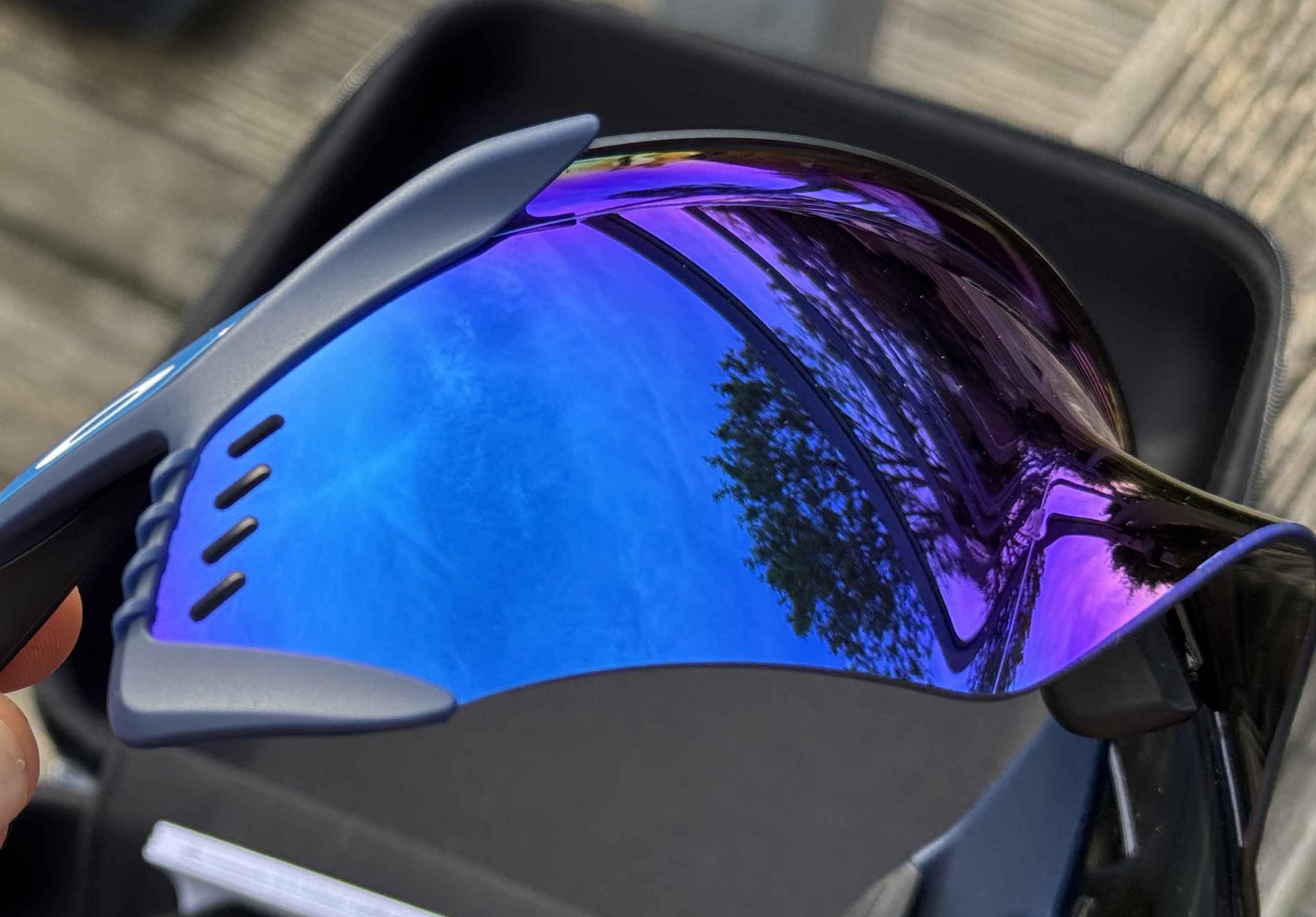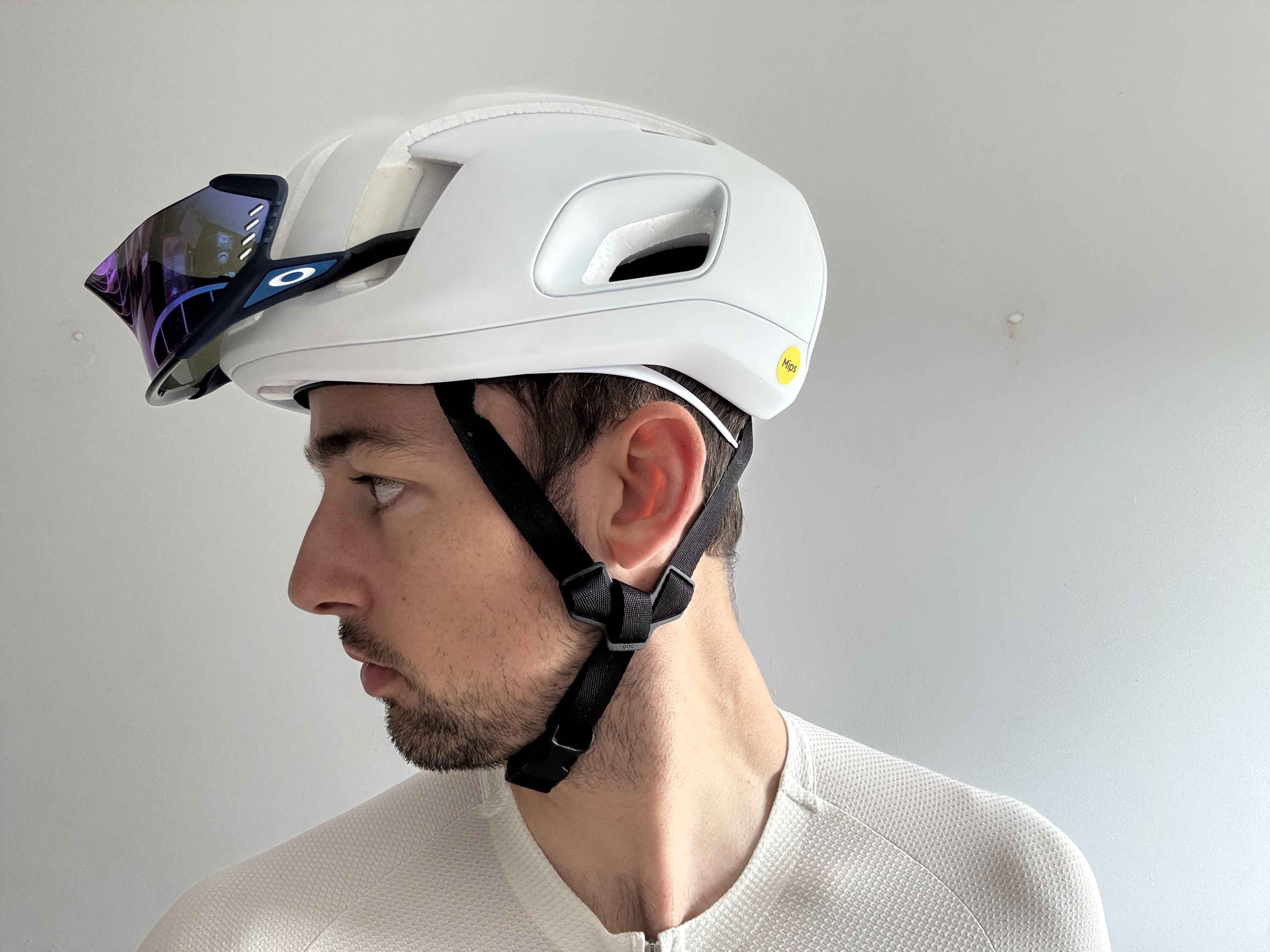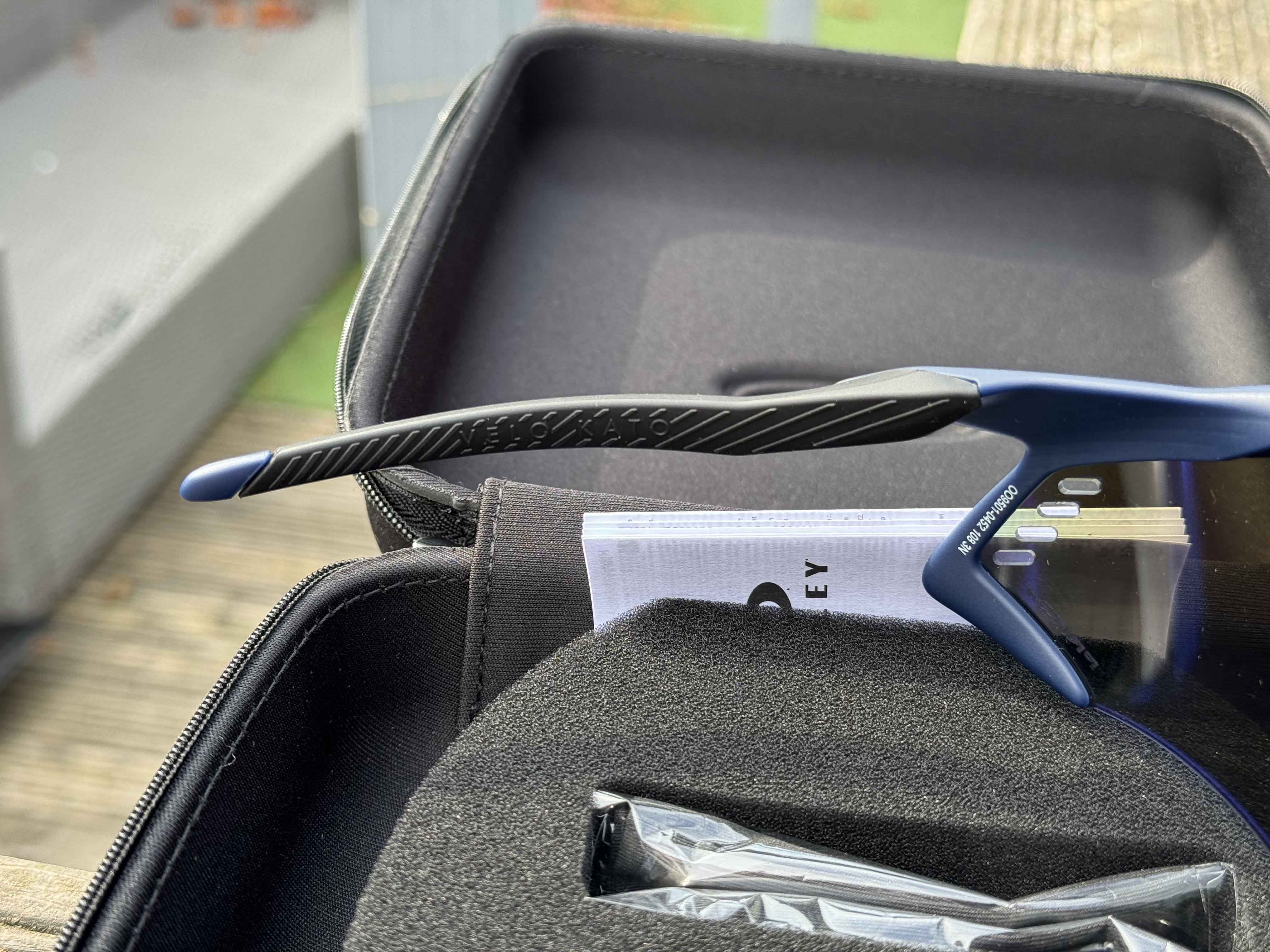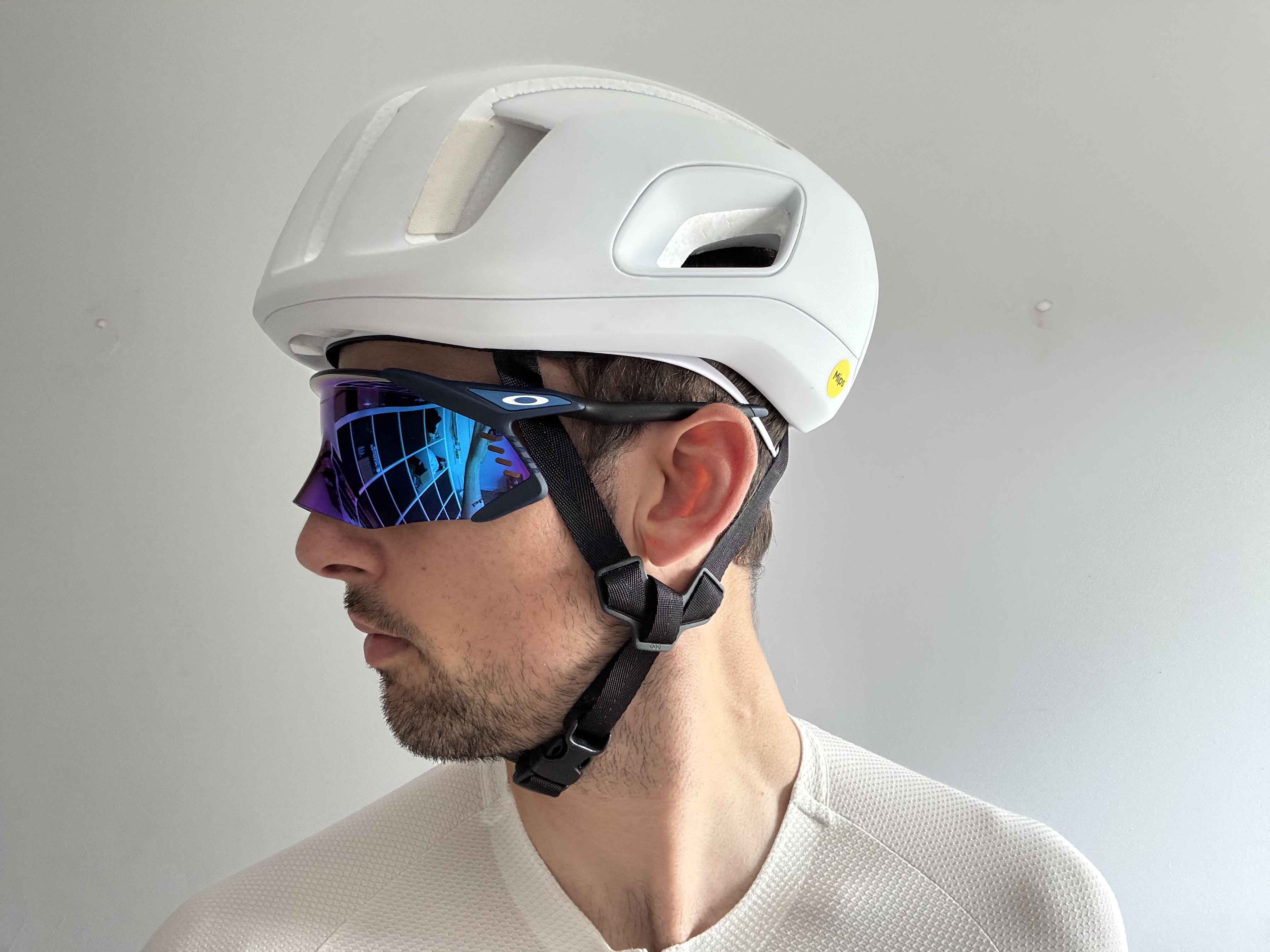The Oakley Velo Kato build on the previous Kato design with several updates and new features. The standout feature of these glasses is the huge wraparound, visor-like lens. Using Oakley’s PhysioMorphic technology, the lens not only wraps around all planes to create a spherical wrap across and down the face, but also extends out as a sort of nose cover.
This allows the lens to be as close to the face as possible without being in contact directly to any part. Often with cylindrical lenses there are gaps at the side or they can sit too close in the centre.
Construction
This lens also features another Oakley staple, the Prizm lens technology. Designed to enhance contrast and reduce glare, this makes spotting changes in road surface, texture, or obstacles easier. These Sapphire lenses are particularly heavily tinted, with Category 3 lenses that allow for 12% light transmission.
Prizm Road for example allows a 20% transmission. These lenses are also hydrophobic, oleophobic, scratch resistant, and impact resistant, so clarity of vision should remain high even over time and in poor weather conditions.
Another carry on feature is the use of Unobtanium on the arms of the glasses and the nose piece. This is Oakley’s proprietary grippy material that aims to keep the glasses securely on the face while not degrading over time or after exposure to sweat. A ribbed texture on the arms is also targeted at keeping the glasses in place.
Where things start to really differ from the previous Kato is the frame. This now extends more above and below, which should give a bit more lens protection especially when placing them on a surface. Oakley have also added what they call flow conditioner tabs on the sides to direct the flow of air better when paired with the Velo Mach aero helmet released in conjunction with these glasses and Tudor Pro Cycling.
To further aid this aspect of performance, the arms are hingeless and don’t fold – like the old Pro M frames from 20 years ago. To account for this a much larger zip up hard case is supplied with the glasses along with spare nose pad and cleaning cloth. Lenses however cannot be changed. Instead one of the eight different colour or lens options must be bought in full for different lens options. Weight comes in at 41g.
A rigid frame means a bigger case.
(Image credit: Andy Turner)
How we used the velo katos
Out of the box, the Oakley Velo Kato are quite different to any other glasses I’ve used before. Taking them out of the box, they immediately feel more akin to a visor with arms. It’s not a common design, with the Alba Optics Mantra being the only other current pair I’ve seen go hingeless in the pursuit of performance.
Putting the glasses on my face is where they really do impress. Oakley’s PhysioMorphic len is similar to other spherical lenses, in that bending around multiple planes allows the glasses to wrap around the face without leaving gaps at either the sides, the top or the bottom.
Our faces are spherical, not cylindrical, and it’s a gripe of mine that most cycling sunglasses now use cylindrical lenses which leave openings for daylight, wind, rain.
Where the Velo Kato differs and is fairly unique compared to other brands, is that the lens is shaped to fit over and around the nose, rather than featuring a cut out. It’s the same as the standard Kato, and to a lesser degree the Encoder glasses. It looks a bit like Scicon’s ‘aero beak’ used by Dylan Groenewegen, but a lot neater. The lens also houses the attachment for the nose piece, impressively all of this is one single piece of polycarbonate.

Oakley lenses incorporate shape without adversely effecting the optics
(Image credit: Andy Turner)
Staying with the lens, every Velo Kato option uses Oakley’s top of the range Prizm lenses, designed to enhance colours and contrast, and reduce glare. Out on the road this works brilliantly.
Riding in dappled light conditions under trees, the Prizm lenses work to bring out the shadows and therefore changes in the road surface. It is still one of the best lens technologies available and makes for superb optics. Additionally riding early in the day or late at night with low sun, there were no issues of glare even in direct sunlight.

The arms of the Velo Kato slotted nicely into the vents of the POC Cytal
(Image credit: Andy Turner)
The sheer size of the lens gives full face coverage. This does however have the side effect of being even more polarizing in the style stakes. Every single person who has seen them has had a comment about them, and they vary in either seeing them as very cool, or just way too much.
I quite like the locked-in sensation of putting them on and seeing nothing but the lens, completely unobstructed by bits of frame or light. This gives ski-goggle like protection; great for colder starts where wind chill tends to make my eyes water.
Moving onto the frame, and this is a bit of a strange one. A big change is now that the arms, where the lens attaches to, extend across the top and bottom of the lens more, offering protection against impacts if they are put onto hard surfaces. At the side there are ‘flow conditioners’, but at present there is no aero data to support this having an effect on performance. The POC Propel aero glasses for example claim a modest 1 watt saving, so expect something around that and decide for yourself if it’s worthwhile.
The lack of hinges though is an odd choice as Oakley ditched this design element back in the noughties when they stopped making the Pro M frames, the glasses of choice for Lance Armstron.
These are heavier glasses at 41g, so weight saving is not a consideration. Stashing the glasses away in helmet vents is also easy as the arms have a degree of flex and the grippers keep them secure in vents or on the face. It does mean that for packing they take up more room and they can’t be stashed on the top or rear neck of a jersey or in a pocket.
Perhaps most frustratingly, you can’t change lenses or get replacements, you need to buy another pair of glasses. This also means no prescription lens options are available such as RX clip compatible glasses like the KOO Hype. All this does detract from their practicality, but in some ways that’s the point. The Velo Kato has been made to go fast and give you a clear view of the road ahead.

Without hinges, the Velo Kato frames are more springlike which holds them in place nicely.
(Image credit: Andy Turner)
Oakley velo katos: Value
£271 is a lot of money to pay for a pair of sunglasses. Given that Oakley have Prizm lens glasses options such as the Oakley Sutro available at £159, the Velo Kato comes with a massive premium. A level of that will be the PhysioMorphic lens technology which requires a great deal more manufacturing than other lenses, and the price is the same as the standard Kato.
It is a fact that the quality of the lenses is superb, and the huge wrap around lens gives a nearly unrivalled field of view without any obstruction. It does also have a unique look that is bound to turn heads and draw attention if that’s what you want. However it is impossible to wear this in any way that could be described as understated. It is a statement piece.
There are also practical issues such as the arms not folding, no replacement lenses meaning for a clear lens you need to shell out another £271, and no prescription inserts. It is an impressive piece of kit that does perform well, but there are both more practical and far better value options available out there. However if you want something that looks unique, and impressively for Oakley likely won’t be seen on the group ride very often, this may be the pair of glasses for you.
Oakley velo katos: Conclusion

The Velo Kato give ski-goggle-like protection for your eyes
(Image credit: Andy Turner)
The Oakley Velo Kato glasses are a proper statement piece. Practicalities are forgone in favour of out and out performance to the nth degree. The PhysioMorphic is a marvel of lens engineering and wraps around the face both protecting you from the elements and giving unparallelled field of vision. Add to that the same great quality of optics to be expected with Oakley Prizm lenses, and you have a real high performer here. But for £271, it needs to perform that well, and some.
A lack of arm hinges and inability to switch lenses detracts massively from the value and practicality of these glasses to the extent that these really are surplus to most people’s requirements. If you want a pair of glasses that can do it all, these are not the ones. But if you want something entirely performance orientated, money no object, then the Velo Kato certainly hit the mark.
